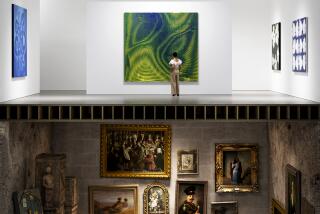The Masterpiece by Thomas Hoving (Simon & Schuster: $17.95; 321 pp.)
- Share via
Sir Peter Grundy, director of the London auction house, Williams, has made a great coup, he has snatched the sale of a great Velasquez from both Sotheby’s and Christie’s. Thus begins the first novel by the former director of the Metropolitan Museum, Thomas Hoving, with Sir Peter running over in his mind the roster of museum directors and collectors who will vie for the painting in a competition that will be an exercise in guile and power. Readers in the know will recognize at once that the name of the firm, Williams, is an unenigmatic cognominal parallel for Phillips, a real auction house, and will expect, then, that the mulled over museum directors and collectors are slightly disguised known figures of the art world; this promise of scandal and gossip--and it’s there--adds a needed spice to the plot, which is remarkably similar to that of Tom Baird’s much better “The Old Masters” of 1963.
The main contenders for the purchase are, naturally, American institutions with the most money. The aggressive fictional directors of our two richest--and in the novel rival--museums, Olivia Cartright of the Metropolitan, and Andrew Foster of the National Gallery are the yin and yang of the perfect director: she an elegant scholar, he a fine administrator. They are also clearly complementary alter egos of the author. The male half of the alter ego, Andrew, is young, smart and rich; he reminds Sir Peter of Cary Grant, a thought that immediately sends the reader for another look at the photo on the dust jacket. The female half, Olivia, is of course beautiful and intelligent, very ambitious, and if not born rich, endowed with an expense account that allows her to live somewhat as if she were. Although the antagonists are supplied with wonderful qualities by the author, they speak in an unlikely stilted mixture of pedantry and slang; the Velasquez is, according to Olivia, “a smash, a power-packed act of genius. . . .” The characters are convincing only in action.
With Olivia and Andrew, we get to fly around with the Concorde set, and by them, we are treated to discussions and demonstrations of connoisseurship and the scientific testing of authenticity, lectured to about various masterpieces in the Louvre and the Prado, told how museums finance their purchases, taught the tactics of bidding at auction, and made privy to quarrels in the board room. The scenes in the board room are the best in the book, perhaps it was there that director Hoving had his most vivid experiences and fantasies. In fact, most of these “inside views” really are treats, plump raisins in the watery flan of Hoving’s prose. For who, after all, should know better about such matters than Hoving, who, during his tenure at the Metropolitan, practically mortgaged the institution to buy a great Velasquez?
Almost everyone in the book is corrupt (except for a few members of the English nobility), and practically all the money is tainted, a situation that Hoving delights in and that the two rival museum directors exploit. They themselves are relatively free of background corruption--thought of here as “errors”--for Olivia has reached her position by scholarship and wit, and Andrew innocently “grew up rich,” as he recounts in several pages of decorator magazine prose. With few scruples and no reference to professional ethics, the two manage to conquer all their “implacable” rivals one after the other by getting the goods on them. Andrew is (it seems ex officio) a CIA agent and can phone headquarters for inside info at anytime. And although a simple civilian, Olivia has her personal Deep Throat, an Italian-dwarf-art expert-computer-billionaire-hacker-Count, who in every crisis gives Olivia the necessary dirt on the opposition. Their use of this information and other unethical activities would scarcely warrant belief, except for the ineluctably teased up suspicion, “Did Hoving himself do this?
The goals of museums, and the everyday activities of overworked and underpaid curators and their staffs are forgotten or ignored, superseded by the exalted sense that museum directors have of their own importance in the world.
Unless you are fascinated by the gossip, or how museums might function on the more spectacular upper levels--and can stand several lectures on art history pretending to be conversation--it would be best to wait for the TV movie. It’ll have better dialogue.
More to Read
The biggest entertainment stories
Get our big stories about Hollywood, film, television, music, arts, culture and more right in your inbox as soon as they publish.
You may occasionally receive promotional content from the Los Angeles Times.










